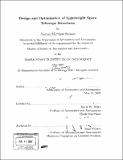Design and optimization of lightweight space telescope structures
Author(s)
Stewart, Andrzej Matthew
DownloadFull printable version (19.56Mb)
Other Contributors
Massachusetts Institute of Technology. Dept. of Aeronautics and Astronautics.
Advisor
David W. Miller.
Terms of use
Metadata
Show full item recordAbstract
As mankind attempts to look deeper into the universe, increasingly larger space telescopes will be needed to achieve the levels of resolution required to perform these missions. Due to this increase in size, increasing emphasis will be placed on designing lightweight, efficient structures in order to reduce structural mass and minimize launch costs. This thesis discusses several issues related to the design of lightweight space telescopes. Three topics are presented. The first topic deals with the design of a secondary mirror support structure. A simple tripod design is studied and optimized in detail. Several baffle--type designs are also studied and compared to the tripod. Finally, the buckling behavior of the bars in the structures is considered. The second topic deals with localized effects around the attachment points of actuators on a deformable mirror. Using a least-squares method and the coefficient of multiple determination, deformation results from a finite element model are compared to an ideal deformation shape obtained from beam bending theory. Using these results, an optimum set of dimensions is found for the actuator standoff posts that minimizes the deviation of the finite element results from the ideal shape. (cont.) Finally, the third topic deals with launch loads, which are usually the most severe loads a spacecraft will encounter. A quasi-static launch load analysis procedure is implemented for a finite element model of a hexagonal mirror segment, and a mathematical framework for dynamic analysis is identified. Parameterized, medium-fidelity finite element models are utilized throughout the thesis. These models allow for rapid evaluation of a large number of different designs, and can be used to evaluate large design spaces in order to find optimum designs.
Description
Thesis (S.M.)--Massachusetts Institute of Technology, Dept. of Aeronautics and Astronautics, 2007. Includes bibliographical references (p. 137-140).
Date issued
2007Department
Massachusetts Institute of Technology. Department of Aeronautics and AstronauticsPublisher
Massachusetts Institute of Technology
Keywords
Aeronautics and Astronautics.